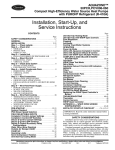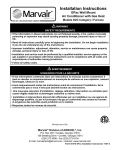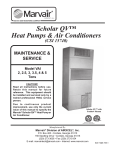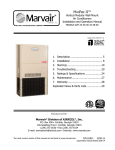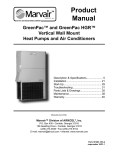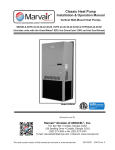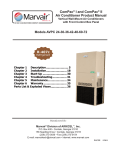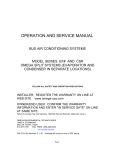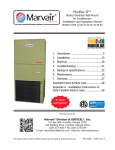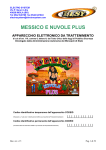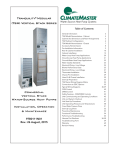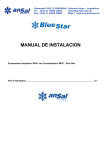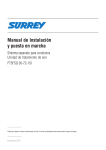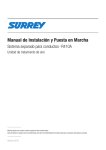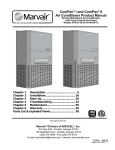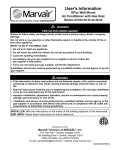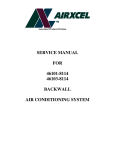Download Scholar III™ Heat Pumps & Air Conditioners (CSI 15740)
Transcript
Scholar III™ Heat Pumps & Air Conditioners (CSI 15740) MAINTENANCE & SERVICE Model VAIA 2, 2.5, 3, 3.5, 4 & 5 Tons CAUTION!! Read all instructions before use. Retain this manual for future reference. This equipment should be installed and serviced only by a trained professional HVAC service person. Due to continuous product improvement, use only the current issue of this manual. The latest version can be downloaded from the Marvair website - www.marvair.com. Scholar III™ ER I E D TO A R I A S C C UNIT ITIO MA NING R EQ UIPMEN LY I N G W I T H ND AR O Y AIR MP N U FA C T U R TIF O ER C T AR 0 AIR S2 1 SI S TA NNDDAARRDD TA Unitary Air-Conditioners AC Unitary Air-Source Heat Pumps HP Manufactured By: Marvair Division of AIRXCEL®, Inc. ® P.O. Box 400 • Cordele, Georgia 31010 156 Seedling Drive • Cordele, Georgia 31015 (229) 273-3636 • Fax (229) 273-5154 E-mail: [email protected] • Internet: www.marvair.com SIII M&S 8/09-1 SECTION 15700 Heating, Ventilating and Air Conditioning Equipment MAINTENANCE & SERVICE manual for scholar IIITM heat pump & Air conditioner, model VAIA (csi 15740) Table of contents Chapter 1.1 Description Page General Description...................................................................3 1.2 Model Identification...................................................................4 2.1 Start-up Instructions..................................................................5 2.2 Ventilation System Calibration.....................................................7 3.1 Electrical...................................................................................9 4.1 Maintenance...........................................................................14 5.1 Function & Description of Primary Components.......................... 14 6.1 Troubleshooting.......................................................................26 7.1 Service...................................................................................36 8.1 Filing a Service/Warranty Claim................................................55 9.1 Warranty Statement.................................................................56 10.1 Exploded Views and Parts List..................................................57 Scholar IIITM (M&S) 8/09-1 15700 - 2 HVAC Equipment SECTION 15700 Heating, Ventilating and Air Conditioning Equipment The purpose of this manual is to provide instructions for maintenance and service for the Marvair® Scholar III™ series of heat pumps and air conditioners. In addition to this manual, there are other pieces of literature available from Marvair. The Engineering and Design Manual details the design and selection of HVAC systems using the Scholar III series. The Installation and Start-Up manual covers the installation of the unit and various accessories and the initial start-up of the unit. An overview of the product line can be found in the Heat Pump and Air Conditioner Product Data Sheets. The current version of this literature can be found and downloaded from the Marvair website at www.marvair.com. To minimize sound levels within the classroom, certain options should be selected. These options are designated by throughout the guideline. 1.1General Operation A. Scholar III™ heat pumps and air conditioners are designed to provide quiet comfort to the classroom. In cooling mode, the compressor will cycle on to provide the cooling required. The system provides cooling, dehumidification and air circulation. In heating mode the compressor (heat pump only) will cycle on to provide the heating required. The system provides heating and air circulation. At lower outdoor temperatures, additional heating capacity may be provided by an optional electric resistance heater or a hot water/steam coil. Ventilation air may be provided by the manual or motorized fresh air vent, power vent or GreenWheel® ERV. These ventilation systems operate when there is a call for cooling or heating or independently to provide fresh air. Note that with the manual, motorized fresh air vent and the power vent options, if the compressor is not operating and the indoor blower is running, unconditioned outside air is being introduced into the classroom. The GreenWheel ERV provides tempered outside air. Control systems are either a remote external thermostat, internal thermostat, or a direct digital control interfacing with the building automation system (BAS). Hot Gas Reheat (HGR) Dehumidification (Option). To provide on demand dehumidification, the Scholar III™ heat pump or air conditioner can have a factory installed hot gas reheat coil to allow dehumidification through continued cooling with discharge air reheated to avoid over cooling the classroom. The hot gas dehumidification option can be used with electric, steam or hot water heat. The operation of the HGR is controlled by a three-way heat reclaim valve. The HGR coil is sized to provide a heating capacity approximately equal to the sensible capacity of the unit When the demand for cooling is satisfied and the humidity controller calls for dehumidification, hot gas is directed to a reheat coil downstream from the evaporator coil to add heat to the dehumidified, chilled air supplied to the classroom. Hot gas Scholar IIITM (M&S) 8/09-1 15700 - 3 HVAC Equipment reheat is available with motorized fresh air, PowerVent and GreenWheel® ventilation systems. Marvair® recommends that for optimum performance, hot gas reheat be used in conjunction with the GreenWheel® heat recovery ventilator. When used with other ventilation options, hot gas reheat may not maintain satisfactory control of the humidity in the classroom over all outdoor conditions. Figure 1. Conditioned Air Flow and Fresh Air Flow 1.2Model Identification The Scholar IIITM heat pump and air conditioner identification numbering system is shown below. The model identification number is on the data label. The data label is at the bottom of the of left side panel. VAI S A • • • • • • III Configuration III = Scholar III Nominal Cooling 2-Stage Compressor Vertical Air Indoor Source Refrigerant R-410A 24 = 24,000 BTUH 30 = 29,000 BTUH 36 = 35,000 BTUH 40 = 40,500 BTUH 48 = 48,000 BTUH 60 = 59,000 BTUH Power Supply A = 208/230V,1,60Hz C = 208/230V,3,60Hz D = 460V,3,60Hz System Type HP = Heat Pump AC = Air Conditioner Configuration N = Manual Damper (std) H = GreenWheel® ERV Q = GreenCube™ ERV B = Motorized Damper Heat – kW J = Power Vent with Motorized Damper 000 - No Heat 050 = 5 kW 075 = 7.5 kW 100 = 10 kW 150 = 15 kW 099 = 99 (Hot Water) Special Options G = Hot Gas Reheat/Dehumidification IMPORTANT WHEN SCHOLAR III SYSTEMS ARE INSTALLED, MODEL NUMBER AND SERIAL NUMBERS ARE TO BE RECORDED AND MAINTAINED IN A LOCATION FOR IMMEDIATE ACCESS WHEN REQUESTING FURTHER INFORMATION. TM Scholar IIITM (M&S) 8/09-1 15700 - 4 HVAC Equipment 2.1 Start-up procedure A. This start-up procedure applies to Scholar III™ models equipped with a remote (wall mounted) thermostat and electric supplemental heat. 1. Turn the disconnect in the Scholar III™ unit to “OFF” position and double check all electrical connections before applying power. 2. Check the voltage supply to the disconnect. If voltage readings are appropriate, proceed with start-up. (See Figure 2 for acceptable voltage ranges.) If voltage readings are not appropriate, check the power leads at the disconnect and the main breaker in the mechanical room. Take appropriate corrective action to supply sufficient voltage to the Scholar III™ disconnect. Figure 2. Voltage Limitations Electrical Voltage Designations* A Nominal Voltage 208/230 Phase 1 Minimum Voltage 197 Maximum Voltage 253 *Letters refer to model number code designations. Example: VAIA 36 HP A C 208/230 3 197 253 D 460 3 414 506 Voltage 3. Turn the Scholar III™ disconnect to “ON” position. 4. Cooling a. Set the remote thermostat system switch to “OFF” position. The blower switch should be in “AUTO” position. b. At the remote thermostat, raise the cooling set point several degrees above room temperature. Lower the “heating” set point several degrees below room temperature. c. Move the blower switch on the remote thermostat from “auto” to “on” position. The indoor blower should come on, as evidenced by sound and air blowing out of the air supply grille. d. Move the blower switch on the remote thermostat from “on” to “auto” and the indoor blower will stop 90 seconds later. e. Move the system switch on the remote thermostat from “off” to “cool.” Slowly lower the cooling set point to just below room temperature and bring on cooling. Check to see that when the heat pump comes on that the air coming out the discharge grille is cooling. Let unit run for five minutes in this mode. If heat pump continues to run and provide cooling, this verifies that the indoor blower, compressor and outdoor blower are all running. Scholar IIITM (M&S) 8/09-1 15700 - 5 HVAC Equipment f. Now slowly raise the cooling set point up toward room temperature until the pump compressor and outdoor blower motor turn off. This will be audible. The indoor blower will continue to run and turn off after 90 seconds. 5a. Heating (heat pump version only) a. Put the thermostat system switch to “Heat” mode. Wait five minutes after testing on cooling, before testing in heating mode. b. Slowly raise the heating set point above room temperature until the heat pump comes on. The indoor blowers will start and the heat pump will provide warm air from the air supply grille. Let run for five minutes. c. Slowly lower the set point temperature until the heat pump compressor and outdoor blower turn off. The indoor blower will turn off 90 seconds later. 5b.Heating (air conditioner version only) a. Set the heating set point below room temperature and put the thermostat system switch on “Ht.” b. Raise the set point slowly and the indoor blower and the electric supplemental heat will turn on at the same time. c. Lowering the set point slowly should turn the electric heat off. The indoor blower will turn off 90 seconds later. 6. Automatic Changeover For an automatic changeover remote thermostat, the proper functioning of the system can be checked for cooling and heating by using the same sequence as detailed above with the thermostat system switch put in “AUTO” position. 7. Emergency Heat (heat pump version only) This setting on a remote thermostat is to provide electric heat in the event the compressor does not function, and heat is required. In emergency heat mode, the compressor is de-energized and electric heat supplies all heating, controlled by the thermostat. To check this out, set the heating set point below room temperature and put the thermostat system switch on “Em. Ht.” Raise the set point slowly and the indoor blower and the electric supplemental heat will turn on at the same time. Lowering the set point slowly should turn the electric heat off. The indoor blower will turn off 90 seconds later. Scholar IIITM (M&S) 8/09-1 15700 - 6 HVAC Equipment 2.2ventilation system calibration The ventilation system requires calibration to ensure the appropriate amount of fresh air is delivered to the classroom. Refer to the appropriate following ventilation system and use the instructions to calibrate the system for correct air delivery. A. Manual Fresh Air System. Fresh air ventilation by means of a damper with pressure relief (opening to outside, but no exhaust blower), a ventilation intake blower and a fan speed controller provides up to 450 cfm of outside air. The damper can be manually adjusted at installation to provide the required ventilation airflow. The fresh air door should be set in accordance with the amount of fresh air flow required, up to a maximum of 450 CFM. Figure 3 illustrates the fresh air door settings and air flow rates. Follow the directions in Figure 3 to ensure proper air flow rate settings. B. Motorized Fresh Air - Configuration B. This ventilation option includes a motorized damper, a fresh air intake blower and motor, and a blower motor speed controller. This ventilation option can provide up to 450 CFM of outside air (but not to exceed 40% of rated airflow) and includes pressure relief (opening to outside, but no exhaust blower). The motorized damper and blowers are controlled by a Programmable Logic Controller (PLC). The PLC will operate the damper and ventilation motors ONLY when the Indoor/Evaporator blower is operating. The PLC is factory wired for this operation by a 24 VAC signal to an input terminal on the PLC. The damper is adjusted after installation for the required rate of ventilation. An optional 24 VAC, 120 VAC or 240 VAC coil relay may be factory installed to control the damper and motor from an external signal, e.g. an EMS or BAS system. A filter on the incoming outside air is standard. PowerVent - Configuration J (Optional). This ventilation option includes a motorized damper, a fresh air intake blower and motor, an exhaust air blower and motor and one blower motor speed controller. The blower speed controller operates both blowers in tandem. (An optional blower speed control for the exhaust air blower can be factory installed to provide independent control of the exhaust air blower motor and allow pressurization of the classroom).The PowerVent can provide up to 450 CFM of outside air (but not to exceed 40% of rated airflow) and includes active pressure relief. The motorized damper and blowers are controlled by a Programmable Logic Controller (PLC). The PLC will operate the damper and ventilation motors ONLY when the Indoor/Evaporator blower is operating. The PLC is factory wired for this operation by a 24 VAC signal to an input terminal on the PLC. The damper is adjusted after installation for the required rate of ventilation. An optional 24 VAC, 120 VAC or 240 VAC coil relay may be factory installed to control the damper and motor from an external signal, e.g. an EMS or BAS system. A filter on the incoming outside air is standard. The fresh air door is opened and closed by the motorized drive. Calibration, as shown in Figure 4, will ensure the required amount of air, up to a maximum of 450 CFM, is delivered to the classroom. Scholar IIITM (M&S) 8/09-1 15700 - 7 HVAC Equipment Follow the directions in Figure 4 to ensure the proper air flow rate setting. After calibrating the ventilation system, replace the lower front cabinet panel. Figure 3. Manual Fresh Air System Calibration Procedure Inside the lower section, locate the circular calibration plates as noted in the drawing (“A” is fixed, “B” is movable). Remove the screw shown by the arrow from “Manual Settings.” Rotate plate B in a clockwise direction until the hole from which the screw was removed aligns with the hole adjacent to the desired air flow rate, in CFM. Reinsert the screw into the hole in plate B and firmly drive the screw through the appropriate air flow rate hole, so plate B is securely fastened at the desired opening. Figure 4. Motorized and PowerVent System Calibration Procedure Inside the lower section, locate the circular calibration plates as noted above in the drawing (“A” is fixed, “B” is movable). Remove the screw shown by the arrow from “motorized settings.” Reinsert the screw into the hole in plate B adjacent to the desired air flow rate, in CFM, and firmly drive the screw in until it bottoms out at the screw head. C. GreenWheel® ERV. Using best industry standards and practices, measure the fresh air that is being brought into the classroom. For units with one speed controller (std.), adjust the speed of the intake and exhaust blowers by inserting a slotted screw driver into the opening on the controller. The speed controller is located in the control box. Measure the intake air again and adjust the speed of the blowers. Repeat as necessary to meet the fresh air requirements. For units with the optional variable fan speed controller for the exhaust blower on the GreenWheel® ERV, first measure the air being introduced into the classroom using best industry standards and practices. Adjust the speed of the intake air blower until the required outside air is being brought into the classroom. Now measure the exhaust air from the classroom. Adjust the speed of the exhaust air blower until the required air is being exhausted from the classroom. The exhaust air controller is in the control box. It is usual practice to pressurize the classroom by exhausting slightly less air than is being brought into the classroom. Scholar IIITM (M&S) 8/09-1 15700 - 8 HVAC Equipment 3.1 ELECTRICAL Scholar III heat pumps and air conditioners are built in a wide variety of configurations and options. The illustrations of the control center and the electrical schematics shown here are typical, but probably are not identical to your units. Please refer to the electrical schematic in each unit for the specific construction of that unit. Figure 5. Typical Control Center Layout for Models VAIA24/30/36/40 Scholar IIITM (M&S) 8/09-1 15700 - 9 HVAC Equipment Figure 7a. Typical Wiring Schematic for Heat Pump Model VAIA, Single Phase Power Scholar IIITM (M&S) 8/09-1 15700 - 10 HVAC Equipment Figure 7b. Typical Wiring Schematic for Air Conditioner Model VAIA, Single Phase Power Scholar IIITM (M&S) 8/09-1 15700 - 11 HVAC Equipment Figure 8a. Typical Wiring Schematic for Heat Pump Model VAIA, Three Phase Power Scholar IIITM (M&S) 8/09-1 15700 - 12 HVAC Equipment Figure 9a. Remote Wall Mounted Thermostat Wiring Detail O X Y A G H R E W2 Thermostat Field Supplied Seven (7) Conductor, Color Coded Thermostat Cable R Y A O G W2 C GeoScholar Heat Pumps Note: A/C’s do not have “O”. THE INTERNAL TRANSFORMER IS NOT DESIGNED TO POWER OTHER EXTERNAL DEVICES. Figure 9b. Humidity Controller Wiring Detail O X Y A G H W2 E R Thermostat Field Supplied R Y A O G W2 C Scholar IIITM (M&S) 8/09-1 15700 - 13 HEAT PUMP*LOW VOLTAGE SECTION Seven (7) Conductor, Color Coded 18 Gauge Thermostat Cable *A/C’s do not have “O”. Humidity Controller HVAC Equipment 4.1MAINTENANCE warning before performing maintenance on the scholar III™, switch electric power off at the disconnect located behind the RIGHT FRONT DOOR. Failure to do this could result in property damage, bodily injury or death. A. Air filters on the Scholar III™ model VAIA require scheduled inspection and maintenance. They should be inspected and cleaned or replaced twice a year, as a minimum, before the heating and cooling season. They should be inspected more often, as necessary. Please refer to Chapter 7.1 for instructions on accessing the return air filters. The GreenWheel® Media can be checked visually for excessive dirt build-up. If there is residue build-up on the GreenWheel media, it can be vacuum-cleaned, in place, as necessary. See Chapter 7F for access to the GreenWheel for cleaning. Check it and vacuum clean as necessary. Also check to see that the rubber drive belt is properly engaged on the GreenWheel and drive motor pulley. B. Cabinet Panels/Indoor Grilles may be cleaned with a sponge and warm, soapy water or a mild detergent. Do not use bleach, abrasive chemicals, or harmful solvents. C. If the Indoor Coils becomes clogged or dirty, it may be cleaned by careful vacuuming or with a commercial evaporator cleaning spray. DO NOT use a solvent containing bleach, acetone, or flammable substances. Turn off power before cleaning. Be careful not to wet any of the electrical components. Be sure the unit has dried before restarting. See Chapter 7.3 for instructions on cleaning the indoor coils. D. Outdoor Coils. Periodically inspect the outdoor condenser coil and the cabinet air reliefs for dirt or obstructions. Remove foreign objects such as leaves, paper, etc. If the condenser coil is dirty, it may be washed off with a commercial solvent intended for this purpose. TURN OFF POWER BEFORE CLEANING! Be sure that all electrical components are thoroughly dry before restoring power. See Chapter 7.4 for information on cleaning the outdoor coils. D. Condensate Lines. Each Scholar III™ air conditioner or heat pump has one condensate line. The condensate line for the indoor and outdoor drain pans are tied together and the condensate is discharged either through the base of the unit into a floor drain or out of the back of the unit at the bottom of the unit. 5.1FUNCTION AND DESCRIPTION OF PRIMARY COMPONENTS A. Compressor. All Scholar™ units use a fully hermetic scroll compressor to minimize sound levels and maximize efficiency. Scroll compressors, like several other types of compressors, will only compress in one rotational direction. The direction of Scholar IIITM (M&S) 8/09-1 15700 - 14 HVAC Equipment rotation is not an issue with single-phase compressors since they will always start and run in the proper direction. However, three phase compressors will rotate in either direction depending upon phasing of power. Since there is a 50-50 chance of connecting power in such a way as to cause rotation in the reverse direction, it is imperative to confirm that the compressor is rotating in the proper direction at the initial field start-up of the system. Verification of proper rotation is made by observing that the suction pressure drops and the discharge pressure rises when the compressor is energized. An alternate method of verification for self contained system with small critical refrigerant charges, where the installation of gauges may be objectionable, can be made by monitoring the temperature of the refrigerant lines at the compressor. The temperature should rise on the discharge line while the suction line temperature decreases. Reverse rotation also results in a substantially reduced current draw when compared to tabulated values. There is no negative impact on durability caused by operating three phase compressors in the reversed direction for a short duration of time, usually defined as less than one hour. However, after several minutes of operation the compressor's internal protector will trip. The compressor will then cycle on the protector until the phasing is corrected. Reverse operation for longer than one hour may have a negative impact on the bearings. The compressor, reversing valve and coil, and the Schrader fittings are located behind the hinged control box. See figure below. SCHRADER FITTINGS COMPRESSOR REVERSING VALVE CONDENSATE TUBING B. Indoor Blower and Motor. All Scholar III air conditioners and heat pumps use an electronically commutated (EC) blower motor and a single blower. The motor speed is controlled by a pulse width modulator located in the electrical box and identified as IBM. The modulators are factory set for proper air flow for design requirements. Should the modulator need adjustment, use the following procedure. On the face of the modulator, there is an adjustment dial with a slot in the middle. Using a slotted screw driver, gently turn the dial clockwise to increase the air flow and counterclockwise to decrease the air flow. While rotating the adjuster, a numerical flow index is locked on the display. After adjustment, the display shows fan RPM. Scholar IIITM (M&S) 8/09-1 15700 - 15 HVAC Equipment C. Outdoor Air Mover. The outdoor air mover is an axial fan with an asynchronous external rotor motor on the 2, 2½, 3, & 3½ heat pumps and all air conditioners. Scholar III heat pumps, models VAIA & VAISA 48 & 60 use two blowers with electronically commutated motors (ECM). One of the blowers operates a full speed anytime the compressor is on. A fan cycle switch on the second blower cycles the blower on & off to maintain proper refrigerant pressures. The switch closes at 400 psig and opens at 245 psig. Each blower motor is controlled by a pulse width modulator, identified in the control box by OFM 1 and OFM 2. The modulators are factory set for proper air flow for design requirements. Should the modulator need adjustment, use the following procedure. 1. In the middle of each modulator there is a blue dial with a slot in the middle. 2. Using a slotted screw driver, gently turn the dial clockwise to increase the air flow and counterclockwise to decrease the air flow. Read the setting by watching the LAMP flashes. The LAMP continuously flashes out the current setting. After a pause, the LAMP flashes out the tens digit, then the units digit of a number (percent) between 1 and 99. If the lamp stays on, the setting is 100%. Long flashes represent the tens digit, and short flashes represent the units digit. A setting of 23% will flash two longs, and three shorts. The LAMP feature can be used to record an air balance setting, or to precisely set the signal to the ECM motor without using a meter. The outdoor coils, filter drier, high pressure switch, loss of charge switch outdoor orifice, defrost sensor are located behind the middle front door. HIGH PRESSURE SWITCH OUTDOOR ORIFICES LOSS OF CHARGE SWITCH VENTILATION DUCT DEFROST SENSOR Scholar IIITM (M&S) 8/09-1 FILTER DRIER 15700 - 16 OUTDOOR COIL HVAC Equipment D. Indoor/Outdoor Coils. The coils are constructed of lanced, aluminum fins mechanically bonded to rifled, seamless copper tubes. E. Filter Drier - The filter drier performs two functions in the refrigerant circuit. First, it removes foreign particulate matter, e.g. dirt, scale, solder particles from the refrigerant to protect the compressor and other components in the refrigerant system with small openings or close tolerances. Second, it absorbs any moisture in the refrigerant with desiccant granules. F. High and Low Refrigerant Pressure (Air Conditioner) or Loss of Charge (Heat Pump) Switches & Optional (Heat Pump Only) Indoor Coil Freeze Stat. These switches render the compressor and outdoor fan motor inoperative whenever the limits of the high or low pressure switches are exceeded or indoor coil freeze up. In the event of high pressure, the Scholar IIITM unit will turn off and lockout. The high pressure switch opens at 610 psig and resets at 420 psig. The system has a High Pressure Switch (HPS) that indicates a high system pressure. When this occurs, the system will run for five seconds then set a High Pressure Lockout. This lockout condition shuts the system off and flashes the “A” indicator on the PLC quickly at a rate of twice per second. The Low Pressure (air conditioner) or Loss of Charge (heat pump) switches are designed is designed to guard against the operation of the system in the event of a loss of refrigerant. If the Pressure (air conditioner) or Loss of Charge (heat pump) switch opens for more than eight minutes, the system will turn off and a Low Pressure Lockout fault will be indicated by a slow flashing on the “A” LED. The interval for the flash is once per second. In cold weather the pressure in the refrigerant system is low prior to operation. When the Scholar III™ unit starts in the heat pump mode during cold weather, low pressure could cause the system to lock out. To guard against nuisance lockouts, the Scholar III unit will not shut off if the Low Pressure Switch (LPS) comes on during the first eight minutes of operation and the switch has not cycled more than three times in an hour. In other words, the compressor will start and operate for eight minutes even with the LPS switch open three times before causing a lockout on low pressure. Both switches open at 40 psig and close at 60 psig. The high and low pressure switches are resettable at the wall thermostat or by turning power off and then on to the Scholar IIITM unit. A fault LED located on the PLC indicates that a lockout has occurred and whether it is due to high or low refrigerant pressure or indoor coil freeze-up. The LED will flash once per second for low pressure or indoor coil freeze up lockout and twice per second for high pressure lockout. G. Metering Devices. The Scholar III uses a thermal expansion valve on the indoor (cooling) circuit and a fixed orifice on the outdoor (heating) circuit. Scholar IIITM (M&S) 8/09-1 15700 - 17 HVAC Equipment H. Reversing Valve. The reversing valve reverses the refrigerant’s direction of flow in a heat pump, allowing the heat pump to switch from cooling to heating or heating to cooling. I. Exhaust Air Ventilation Blower is used to exhaust classroom in the GreenWheel ERV and Power Vent ventilation options. The blower can exhaust up to 450 CFM of air from the classroom. In the standard configuration, both the exhaust and the intake ventilation blowers are controlled by a single speed controller. This speed controller permits the motor speed to be adjusted for the correct cfm of ventilation air. As an option, a second motor controller may be factory installed to allow independent control of the intake and exhaust air blowers. This allows pressurization of the classroom. All ventilation options have an intake air blower. J. Intake Ventilation Air Blower is used to introduce outside air into the classroom. In the standard configuration, both the exhaust (GreenWheel ERV and PowerVent only) and the intake ventilation blowers are controlled by a single speed controller. This speed controller permits the motor speed to be adjusted for the correct cfm of ventilation air. As an option, a second motor controller may be factory installed to allow independent control of the intake and exhaust air blowers. This allows pressurization of the classroom. K. Electric Resistance Heat is installed above the indoor blower outlet. Electric heat is field installed on all Scholar III units. Electric heat can be used with the freeblow plenum or with ducted air distribution options. The heaters are available in nominal kW of 5, 10 & 15 kW for operation on 208/230v. 1Ø, 208/230 v. 3Ø, and 460v, 3Ø. The model number of the heat pump or air conditioner indicates the power supply and kW. L. Electric Resistance Heat Controls. Included with the electric heat assembly are temperature switches designed to turn power off to the heaters if the temperature is too high. There are two types of temperature switches. The first is an auto-reset type that turns power off to the heater if it senses a temperature of 145°F. When the temperature drops to approximately 105°F, power is restored to the heaters. This auto-reset switch is in the low voltage circuit. The second type of switch is a one time limit switch. If it senses a temperature of 300ºF, power is turned off to the elements. This switch does NOT reset when the temperature drops and must be replaced when it activates. The number and location of both switches is determined by the power supply and the kW of the heaters. M. Hot Water is installed above the indoor blower outlet as shown in the hot water plenum. A diverter valve is a factory installed option with the hot water coil only. Hot water heat is factory installed in the freeblow or the ducted plenums and is plumbed from the top right side of the plenum. As a standard safety feature, each hot water coil has a protective 24 volt freezestat embedded within it to trigger at 35°F and to turn the unit off. Scholar IIITM (M&S) 8/09-1 15700 - 18 HVAC Equipment N. Programmable Logic Controller (PLC) Microprocessor. The Scholar IIITM heat pump uses a factory installed PLC microprocessor to control the operation, the safety switches and function options. LED’s show operational status and provide assistance with diagnosis if troubleshooting is ever required. Various control functions are field selectable. The PLC is also capable of communicating to other Scholar III unit PLC’s to allow run time leveling and does not require additional equipment installed in the Scholar III unit. The PLC microprocessor provides improved reliability because of the reduction of components, the components utilized are more durable and the control box wiring has been simplified. Pertinent statistical data about the life of the refrigeration system can be accessed through the PLC. The PLC microprocessor provides for the following control and operation functions: • Anti-Short Cycle Timer - Prevents the compressor from destructive short cycling due to momentary power interruptions. One of three time intervals can be field selected. • Defrost Timer (heat pump only) - Adjustable defrost control that is based upon both time and temperature. The time interval is adjustable from 30 to 90 minutes. • BAS Control - Provides 24 VAC coil to control operation from Building Automation System (BAS). Note - an additional BAS control relay can be added when 120 or 240 VAC coils are required. The unit control system is factory wired to operate upon an input signal from any appropriate 24 VAC control thermostat or DDC control system. If unit shutdown is desired during unoccupied periods of the temperature controlled space, it may be accomplished by the following: the controls contractor must provide a set of contacts (24 VAC pilot duty) between terminals E1 and E2. When the field supplied contacts between E1 and E2 are closed the system will shutdown. Location The PLC is located in the unit control center. The control center is located behind a panel in the lower right portion of the cabinet. Scholar IIITM (M&S) 8/09-1 15700 - 19 HVAC Equipment On the right side of the PLC there is a small door. Behind the door is a three position micro switch and two control adjustments- an anti short cycle timer and a defrost timer. Each control can be adjusted by turning the knob with a small flat head screwdriver. The indicator on the knob is the gap between the two protrusions with the hollow centers on the knob. (See drawing below). For both control timers, turning the knob clockwise increases the time period. NOTE: Scholar III air conditioners do not have the defrost function. The micro switch has three positions – RUN, TERM & STOP. The switch should be in the RUN position during normal operation. Term is for operation from a remote terminal. Stop is no output/ non-operational. The Anti-short Cycle Timer (ASCT) is located to the far left of the switch. The anti-short cycle timer prevents the compressor from destructive short cycling by allowing the compressor to restart only after a selected time interval has passed from compressor shutdown. The timer begins when the compressor turns off. The time interval is frm 3 seconds to eight minutes in one minute increments. The threesecond setting is used only for factory testing and should NEVER be used when installed in a classroom. Select the desired time interval by rotating the knob to the desired setting. The Marvair® factory set point is 3 minutes. The Defrost Timer (DFT) (heat pump function only) is located next to the three position micro switch. The defrost control is based upon both time and temperature. The DFT initiates a defrost cycle whenever the outdoor coil temperature is 28°F or below and the selected time interval from the previous defrost cycle has been exceeded. Select the desired time interval by turning the DFT knob. When turned completely to the left (counterclockwise), the time interval between defrost cycles is 30 minutes. When turned completely to the right (clockwise), the time interval is 90 minutes. The knob allows setting the defrost time anywhere between 30 and 90 minutes, i.e., mid-way between the 30 and 90 minutes is 60 minutes. The Marvair® factory set point is 30 minutes. PLC Inputs & Outputs The PLC has inputs located along the bottom of the controller and outputs along the top of the controller. An input is a signal to the PLC from either the thermostat, sensors in the Scholar III™ heat pump or air conditioner, or a customer supplied input, e.g., DDC. An output is a signal from the PLC to the heat pump, air conditioner or to the thermostat. Scholar IIITM (M&S) 8/09-1 15700 - 20 HVAC Equipment PLC Inputs The PLC inputs are powered only by 24 VAC. The thermostat inputs are: • • • • G - Blower signal from thermostat Y - Compressor W2 - Second stage heat (heat pump function only) O - Reversing valve (energized for cooling) (heat pump function only) The PLC has indicator LED’s that show the status of all thermostat inputs and sensors. For example, if the “G” LED is on, this means that voltage is present from the “G” terminal on the thermostat. Scholar III™ heat pump and air conditioner sensor or control inputs: • HPS – High Refrigerant Pressure Switch. The HPS is ON during normal operation. No light indicates an open switch. See lockout indicator “A” under Outputs. • LPS – Low Refrigerant Pressure Switch. The LPS is ON during normal operation. No light indicates an open switch. See lockout indicator “A” under Outputs • HUM – Humidity Controller. Used when an external humidity controller operates the Scholar to control the humidity in the classroom. • EHDD – Electric Heat During Defrost. Allows the user to select whether electric heat operates when the heat pump enters into the defrost mode. The units are wired at the factory to prevent the electric heaters from operating during the defrost mode. For operation during defrost, a wire is moved from one terminal to another in the control box. NOTE: for operation of the electric heat during defrost, the electric heat control must be configured to allow simultaneous operation of the electric heat and the compressor. (heat pump only) • SCKT – “S” Circuit. Signal that indicates the electric heat and the compressor can never operate simultaneously. This function is controlled by the electric heat control toggle switch in the control center. The LED should be ON if “Y” is ON, the electric heat is on and the toggle switch is in the S circuit position. (heat pump only) • ODS – Outdoor Thermostat. Determines at what outdoor temperature (factory set at 40°F), the supplemental heat turns on. The LED should be ON if the outdoor temperature is below the ODS set point. (heat pump only) • EMS – Energy Management System. A shutdown input from an external source. • GWR – GreenWheel® ERV Relay. When this LED is lit, the GreenWheel ERV is operating. • DFC – Defrost Control Thermostat. Indicates whether the defrost thermostat is closed. The defrost cycle is based upon both time (see defrost timer) and outdoor coil temperature. (heat pump only) Scholar IIITM (M&S) 8/09-1 15700 - 21 HVAC Equipment PLC Outputs An output is a signal from the PLC to the Scholar III™ heat pump or thermostat. The first four outputs, from left to right, are connected to a 230 VAC supply and thus provide 230 VAC when energized. These outputs are: • OAM - Outdoor Air Motor (Fresh air motor for the GreenWheel® ERV) • IBM – Indoor Blower Motor Relay Note: On early models, this was IFM. • GW - GreenWheel® ERV Drive Motor • RHS - Reheat Solenoid The next five outputs are 24 VAC. These outputs are: • CC - Compressor Contactor • HTR - Heat Contactor • RVS - Reversing Valve (heat pump only) • A - Lock Out Indicator. A blinking LED indicates that a pressure switch has opened. A flash rate of once per second indicates a low pressure switch lockout. A flash rate of twice per second indicates a high pressure lockout. • OFM - Outdoor Fan Motor Relay On the left side beneath the Marvair® logo are three LED’s that indicate the operational status of the PLC. • SF – System fault indicates an internal fault in the PLC. The fault can be found using the Microwin Programming System and an external PCI cable. • Run – Normal operation. The PLC is on/operational. When the micro switch is in the RUN position, this LED should be lit. • Stop – The PLC is off/non operational. When the micro switch is in the STOP position, this LED should be lit. Scholar IIITM (M&S) 8/09-1 15700 - 22 HVAC Equipment Operation Guide Cooling Mode During normal operation of the system, the thermostat calls for cooling by turning on the G, Y and O inputs to the system. This request will be indicated on the G, Y and O indicators at the bottom of the unit. If the compressor has been off for a least the amount of time interval set on the ASCT, the Compressor Contactor (CC), Indoor Blower (IBM), Reversing Valve (RVS) and the Outdoor Fan Motor (OFM) LED’s should be on. This indicates that the controller is sending an output to turn those devices on. Heating Mode When the thermostat calls for first stage heating, it turns on the G and Y inputs. The indicators will come on to indicate the thermostat is calling for heat. If the compressor has been powered off for at least the time set on the ASCT, the Compressor Contactor (CC), Indoor Blower Motor (IBM) and Outdoor Fan Motor (OFM) LED’s will be on. The LED’s indicate that the PLC is sending an output to the devices’ controls. If the thermostat calls for second stage heating (heat pump only), the W2 indicator will be lit. If the W2 LED is on, indicating that the thermostat is calling for second stage heat and the ODS indicator is not and the outside temperature is not below the ODS set point, the second stage heat (HTR) will not come on. If the W2 indicator is on and the ODS indicator is on then, in addition to the CC, IBM and OFM indicators, the HTR indicator will be on indicating the call for second stage heat. If the SCKT LED is on indicating that the S Circuit function is selected, the CC and OFM indicators will be off and the HTR indicator will be on. Refer to table below. G Y W2 ODS SCKT IBM CC OFM HTR ON OFF OFF OFF OFF ON OFF OFF OFF ON ON OFF OFF OFF ON ON ON OFF ON ON ON OFF OFF ON ON ON OFF ON ON ON ON OFF ON ON ON ON ON ON ON ON ON ON OFF OFF ON Defrost Mode (heat pump only) When the system has been operating in the heat pump mode for a period of time (set by the Defrost Timer), the system will examine the Defrost Control thermostat Input (DFC). If this input is on (the thermostat is closed), indicated by the LED being on, the system will go into Defrost mode. At this point the Outdoor Fan Motor relay (OFM) is de-energized and the reversing valve is energized. In this mode heat is being applied to the outdoor coil to remove any possible buildup of ice on the coil. The Defrost Control Switch (DFC) comes on at roughly 28°F and goes off at approximately 56°F. During the Defrost Cycle, the unit will continuously examine the DFC input and when it switches off OR the system has been in defrost for 10 Scholar IIITM (M&S) 8/09-1 15700 - 23 HVAC Equipment minutes, the system will revert back to normal heating mode. By having a maximum time for the Defrost Cycle to operate, the system will not go into Defrost and remain in Defrost mode if a Defrost Switch malfunctions. If the Electric Heat During Defrost (EHDD) function has been selected, the Heat Contactor (HTR) will come on to supply supplemental heat during the Defrost Cycle. Low Pressure Lockout The Low Pressure (air conditioner) or Loss of Charge (heat pump) is designed to guard against the operation of the system in the event of a loss of refrigerant. If the Low Pressure Switch stays open for more than eight minutes, the system will turn off and a Low Pressure Lockout fault will be indicated by a slow flashing on the “A” LED. The interval for the flash is once per second. The loss of charge and low pressure switch open at 40 psig and close at 60 psig. In cold weather the pressure in the refrigerant system is low prior to operation. When the Scholar III™ unit starts in the heat pump mode during cold weather, low pressure could cause the system to lock out. To guard against nuisance lockouts, the Scholar III unit will not shut off if the Loss of Charge Switch (LPS) opens during the first eight minutes of operation and the switch has not cycled more than three times in an hour. In other words, the compressor will start and operate for eight minutes even with the LPS switch open three times before causing a lockout on low pressure. High Pressure Switch The system has a High Pressure Switch (HPS) that indicates a high system pressure. When this occurs, the system will run for five seconds then set a High Pressure Lockout. This lockout condition shuts the system off and flashes the “A” indicator quickly at a rate of twice per second. The high pressure switch opens at 610 psig and resets at 420 psig. O. Ventilation Blower Fan Speed Control. The ventilation blower speed control is located in the upper left corner of the electrical control box. Factory setting for the indoor blower speed is full speed. If a lower speed setting is required, the blower motor speed control may be adjusted with a slotted screwdriver rotating the speed control as shown in Figure 12. Reference unit label for minimum required air flow settings for specific unit model. Figure 12. Ventilation Blower Speed Control Adjustment Instructions SERIES 706 VARI-SPEED MOTOR CONTROL LO Scholar IIITM (M&S) 8/09-1 HI 15700 - 24 HVAC Equipment P. Standard Ventilation Control. The motorized fresh air damper with PowerVent and GreenWheel® ERV ventilation options are equipped with a fresh air fan speed control. The fresh air fan speed control operates both the ventilation intake and exhaust blowers together. Optional Ventilation Controls. The unit control system is factory wired to energize the ventilation package anytime the indoor fan/blower is energized. If additional control of the ventilation package is desired, it may be accomplished by the following: The controls contractor must remove the factory installed jumper between terminals V1 and V2 then provide a set of contacts (24 VAC pilot duty) between terminals V1 and V2. When the field supplied contacts between V1 and V2 are closed, the ventilation package will operate when the indoor fan/blower is energized. The motorized fresh air damper with PowerVent and GreenWheel® ERV ventilation options can be equipped with an exhaust fan air speed control, which controls the ventilation exhaust blower independently of the fresh air intake blower. Demand Control Ventilation. A field or factory installed carbon dioxide sensor controls the ventilation damper and only opens the damper when CO2 levels exceed a specified level. Demand control ventilation saves energy and utility costs by ventilating the classroom based upon occupancy. Note: Not available on manual fresh air damper (“B”) configuration. P. Outdoor Thermostat. Factory set at 40°F, this thermostat determines the outdoor temperature at which the supplemental electric heat or wet heat turns on. This may be field adjusted to the desired temperature setting by rotating the adjustment knob in the control box. Please note that when the outdoor thermostat activates wet heat, the compressor does not operate. The outdoor thermostat is located above the hinged control box, behind the middle front door. OUTDOOR THERMOSTAT REHEAT VALVE & SOLENOID VALVE Scholar IIITM (M&S) 8/09-1 15700 - 25 HVAC Equipment 6.1 TROUBLESHOOTING In diagnosing common faults in the heat pump system, develop a logical thought pattern as used by experienced technicians. The charts which follow are not intended to be an answer to all problems but only to guide the technician’s thinking. Through a series of yes and no answers, follow the logical path to a likely conclusion. A novice technician should use these charts like a road map. Remember that the chart should clarify a logical path to the problem’s solutions. Electrical Checks Flow Chart Unit Running? NO Thermostat Problem? YES - Repair and Recheck YES NO Transformer Problem? YES - Repair and Recheck NO Voltage on Compressor Side of Contactor? YES NO Run Capacitor Voltage on Line Side of Contactor? Compressor Internal NO YES Overload Open Compressor Winding Circuit Breakers or Compressor Contactor Open Fuses Open Unit Wiring and High Pressure Cut-Out YES Connections Compressor Winding Low Pressure Cut-Out Grounded Outdoor Fan Motor Compressor Time Grounded Delay Grounded Capacitor Unit Wiring and Connections Replace Fuses or Reset Breakers and Recheck System Scholar IIITM (M&S) 8/09-1 15700 - 26 Go to Mechanical Check for Cooling or Heating HVAC Equipment Cooling Mechanical Checks Flow Chart Unit Running? High Head Pressure Dirty Outdoor Coil Inoperative Outdoor Fan Overcharge Recirculation of Outdoor Air Non-condensibles High Ambient Air Entering Outdoor Coil Wrong Outdoor Fan Rotation YES Pressure Problems? Low Head Pressure Low on Charge Low Ambient Temperature Inoperative Compressor Valves Outdoor Check Valve Closed Restricted Indoor Metering Device Restricted Filter Drier Reversing Valve Failure NO Low Suction Pressure Dirty Filters Dirty Indoor Coil Inadequate Indoor Air Flow Inoperative Indoor Blower Low on Charge Restricted Indoor Metering Device Restriction in System Go to Electrical Checks Flow Chart Recirculation of Indoor Air Wrong Indoor Blower Rotation Inadequate Ducts Outdoor Check Valve Closed Restricted Filter Drier Scholar IIITM (M&S) 8/09-1 15700 - 27 HVAC Equipment Heating Mechanical Checks Flow Chart Unit Running? High Head Pressure Dirty Filters Dirty Indoor Coil Inoperative Indoor Blower Overcharge Inadequate Indoor Air Flow Non-condensibles Wrong Indoor Blower Rotation Inadequate Ducts YES Pressure Problems? Low Head Pressure Low on Charge Low Indoor Temperature Closed Indoor Check Valve Inoperative Compressor Valves Restricted Outdoor Metering Device Restricted Filter Drier Reversing Valve Failure NO Low Suction Pressure Dirty Outdoor Coil Inadequate Air Flow Over Outdoor Coil Inoperative OD Fan Low on Charge Go to Electrical Checks Flow Chart Restricted Outdoor Metering Device Restriction in System Closed Indoor Check Valve Recirculation of Outdoor Air Restricted Filter Drier Defrost Mechanical Checks Flow Chart No Defrost Defrost System Incomplete Defrost Reversing Valve Stuck Poor Sensor Location No Defrost Timer Control Power Failed Defrost Control Wrong Defrost Control Timer Setting Failed Defrost Relay (doesn’t stop O.D. Fan) Thermostat Satisfies During Defrost Failed Defrost Relay Loose Default Sensor Scholar IIITM (M&S) 8/09-1 15700 - 28 Excessive Defrost Wrong Defrost Control Timer Setting Poor Sensor Location Low System Charge Wind Affecting in Defrost HVAC Equipment Subcooling Calculation 1. Measure the liquid pressure at the liquid line service valve. 2. Convert the liquid line pressure to saturated temperature. See tables below. 3. Measure the liquid line temperature at the liquid line service valve. 4. Compare the liquid line temperature to the saturated temperature. 5. The difference between saturated temperature and liquid line temperature is the subcooling. Subcooling normal range 12° to 20°. Superheat Calculation 1. Measure the suction pressure at the suction line service valve. 2. Convert the suction line pressure to saturated temperature. See tables below. 3. Measure the suction line temperature approximately 6” to 8” from the compressor. 4. Compare the suction line temperature to the saturated temperature. 5. The difference between saturated temperature and suction line temperature is the superheat. Superheat normal range 12° to 18° Air Conditioning System Troubleshooting Tips System Problem Overcharge Undercharge Liquid Restriction (Drier) Low Evaporator Airflow Dirty Heat Pump Low Outside Ambient Temp. Inefficient Compressor TXV Feeler Bulb Charge Lost Poorly Insulated Sensing Bulb Discharge Suction Pressure Pressure High High Low Low Low Low Low Low High High Low Low Low High Low Low High High Indicators SuperSubheat cooling Low High High Low High High Low Lo Low Low High High High High High High Low Low Compressor Amps High Low Low Low High Low Low Low High Temperature Pressure Chart Temp. (°F) -40 -35 -30 -25 -20 -15 -10 -5 0 5 10 15 20 R-22 PSIG 0.5 2.6 4.9 7.4 10.1 13.2 16.5 20.0 23.9 28.2 32.8 37.7 43.0 Scholar IIITM (M&S) 8/09-1 R-410A PSIG 11.0 14.2 17.8 21.8 26.1 30.8 35.9 41.5 47.5 54.1 61.2 68.8 77.1 Temp. (°F) 25 30 35 40 45 50 55 60 65 70 75 80 85 R-22 PSIG 48.7 54.9 61.5 68.5 76.0 84.0 92.5 101.6 111.2 121.4 132.2 143.6 155.7 15700 - 29 R-410A PSIG 86.0 95.5 105.7 116.6 128.3 140.8 154.1 168.2 183.2 199.2 216.1 234.0 253.0 Temp. (°F) 90 95 100 105 110 115 120 125 130 135 140 145 150 R-22 PSIG 168.4 181.8 195.9 210.7 226.3 242.7 259.9 277.9 296.8 316.5 337.2 258.8 381.5 R-410A PSIG 273.0 294.1 316.4 339.9 364.6 390.5 417.7 446.3 476.3 507.6 540.5 574.8 610.6 HVAC Equipment Troubleshooting Chart WARNING DISCONNECT ALL POWER TO UNIT BEFORE SERVICING. CONTACTOR MAY BREAK ONLY ONE SIDE. FAILURE TO SHUT OFF POWER CAN CAUSE ELECTRICAL SHOCK RESULTING IN PERSONAL INJURY OR DEATH. Problem/Symptom Likely Cause(s) Correction Unit will not run. 1. Power off or loose electrical connection. 1. Check for correct voltage at unit disconnect. Check for correct voltage at contactor in unit. 2. Reset. 2. Thermostat out of calibration - set too high. 3. Defective contactor. 4. 5. 6. 7. Outdoor fan runs, compressor doesn’t. Blown fuse/tripped breaker. Transformer defective. High pressure control open. Low pressure control open. 1. Run capacitor defective 2. Loose connection. 3. Compressor stuck, grounded or open motor winding, open internal overload. 4. Low voltage condition. Insufficient cooling. 1. Improperly sized unit. 2. Improper indoor air flow. 3. Incorrect refrigerant charge. 4. Air, non-condensibles or moisture in system. Compressor short cycles. 1. Incorrect voltage. 2. Defective overload protector. 3. Refrigerant undercharging. 3. Check for 24 volts at contactor coil replace if contacts are open. 4. Replace fuses/reset breaker. 5. Check wiring - replace transformer. 6. Reset. 7. Reset. 1. Replace. 2. Check for correct voltage at compressor - check and tighten all connections. 3. Wait at least 2 hours for overload to reset. If still open, replace the compressor. 4. Add start kit components. 1. Recalculate load. 2. Check - should be approximately 400 CFM per ton. 3. Charge per procedure. 4. Recover refrigerant, evacuate and recharge, add filter drier. 1. At compressor terminals, voltage must be ±10% of nameplate marking when unit is operating. 2. Replace - check for correct voltage. 3. Add refrigerant. Registers sweat. 1. Low indoor air flow. 1. Increase speed of blower or reduce restriction - replace air filter. High head - low vapor pressures. 1. Restriction in liquid line, expansion device or filter drier. 2. Flow check piston size too small. 3. Incorrect capillary tubes. 1. Remove or replace defective component. 2. Change to correct size piston. 3. Change assembly coil. High head - high or normal vapor pressures - cooling mode. 1. 2. 3. 4. 1. 2. 3. 4. Scholar IIITM (M&S) 8/09-1 Dirty outdoor coil. Refrigerant overcharge. Outdoor fan not running. Air or non-condensibles in system. 15700 - 30 Clean coil. Correct system charge. Repair or replace. Recover refrigerant, evacuate and recharge. HVAC Equipment Troubleshooting Chart (cont’d) Problem/Symptom Likely Cause(s) Correction Low head - high vapor pressures. 1. Flow check piston size too large. 2. Defective compressor valves. 3. Incorrect capillary tubes. 1. Change to correct size piston. Replace compressor. 2. Replace coil assembly. Low vapor - cool com1. Low indoor air flow. pressor - iced indoor coil. 2. Operating below 55°F outdoors. 3. Moisture in system. 1. Increase speed of blower or reduce restriction - replace air filter. 2. Add low ambient kit. 3. Recover refrigerant - evacuate and recharge - add filter drier. High vapor pressure. 1. Excessive load. 2. Defective compressor. 1. Recheck load calculation. 2. Replace. Fluctuating head and vapor pressures.. 1. TXV hunting. 2. Air or non-condensibles in system. 1. Check TXV bulb clamp - check air distribution on coil - replace TXV. 2. Recover refrigerant, evacuate and recharge. Gurgle or pulsing noise at expansion device or liquid line. 1. Air or non-condensibles in system. 1. Recover refrigerant, evacuate and recharge. Service Analyzer Charts Problem/Symptom High superheat. Compressor Overheating Likely Cause(s) Correction 1. Low charge. 2. Faulty metering device. 3. High internal load. 4. Restriction in liquid line. 5. Low head pressure. Low voltage. High voltage. Scholar IIITM (M&S) 8/09-1 1. Check system charge. 2. Restricted cap tube, TXV. Power element superheat adjustment. Foreign matter stopping flow. 3. Hot air (attic) entering room. Heat source on; miswired or faulty control. 4. Drier plugged. Line kinked. 5. Low charge. Operating in low ambient temperatures. 1. Loose wire connections. 2. Dirty or pitted compressor contactor contacts. 3. Power company problem, transformer. 4. Undersized wire feeding unit. 1. Check wiring. 2. Replace contactor. 1. Power company problem. 1. Have problem corrected. 15700 - 31 3. Have problem corrected before diagnosis continues. 4. Correct and complete diagnosis. HVAC Equipment Problem/Symptom High head pressure. Compressor Overheating (cont’d) Likely Cause(s) Correction 1. Overcharge. 2. Dirty heat pump coil. 3. Faulty or wrong size heat pump fan motor. 4. Faulty outdoor blower. 5. Recirculation of air. 6. Additional heat source. 7. Non-condensibles Short cycling of compressor. 1. Faulty pressure control. 2. Loose wiring. 3. Thermostat. 4. Replace blower. Replace with correct rotation motor. 5. Correct installation. 6. Check for recirculating from other equipment. 7. Recover refrigerant, evacuate and recharge system. 8. Faulty run capacitor. 9. Faulty internal overload. 1. Replace pressure control. 2. Check unit wiring. 3. Located in supply air stream. Differential setting too close. Customer mis-use. 4. Internal foreign matter. Power element failure. Valve too small. Distributor tube/tubes restricted. 5. Restricted with foreign matter. Kinked. I.D. reduced from previous compressor failure. 6. Check system charge. 7. Dirty coil. Dirty filter. Duct too small or restricted. 8. Replace. 9. Replace compressor. 1. Fast equalization/low pressure difference. 1. Replace compressor and examine system to locate reason. 4. TXV. 5. Capillary Tube. 6. Low charge. 7. Low evaporator air flow. Faulty compressor valves. 1. Check system charge. 2. Clean coil. 3. Replace fan motor. Electrical Voltage present on load side of compressor contactor and compressor won’t run. 1. Run capacitor. 2. Internal overload. 3. Compressor windings. 1. Check with ohmmeter. 2. Allow time to reset. 3. Check for current ohms. Voltage present on line side of compressor contactor only. 1. Thermostat. 1. Check for control voltage to compressor-contactor coil. 2. High pressure switch. Low pressure switch. Compressor turned off/on control or interlock. Scholar IIITM (M&S) 8/09-1 2. Compressor control circuit. 15700 - 32 HVAC Equipment Problem/Symptom Electrical (cont’d) Likely Cause(s) No voltage on line side of compressor contactor. 1. Blown fuses or tripped circuit breaker. 1. Check for short in wiring or unit. 2. Improper wiring. 2. Recheck wiring diagram. Improper voltage. 1. High voltage. 2. Low voltage. 3. Single phasing (3 phase). Correction 1. Power supply problem. 2. Power supply problem. Wiring undersized. Loose connections. 3. Check incoming power and fusing. Contamination Moisture. 1. Poor evacuation on installation or during service. High head pressure. 1. Non-condensibles air. Unusual head and suction readings. 1. Wrong refrigerant. Foreign matter copper fittings. 1. Copper tubing cuttings. Copper oxide. 1. Dirty copper piping. Welding scale. 1. Nitrogen not used. Soldering flux. 1. Adding flux before seating copper part way. Excess soft solder. 1. Wrong solder material. 1. In each case, the cure is the same, recover refrigerant. Add filter drier, evacuate and recharge. Loss of Lubrication Low suction pressure. 1. Low charge. 2. Refrigerant leaks. 1. Check system charge. 2. Repair and recharge. Cold, noisy compressor - slugging. 1. Dilution of oil with refrigerant. 1. Observe piping guidelines. Noisy compressor. 1. Migration. 1. Check crankcase heater. Cold, sweating compressor. 1. Flooding. 1. Check system charge. Low load. 1. Reduced air flow. 2. Thermostat setting. 1. Dirty filter. Dirty coil. Wrong duct size. Restricted duct. 2. Advise customer. Short cycling of compressor. 1. Faulty pressure control. 2. Loose wiring. 3. Thermostat. 1. Replace control. 2. Check all control wires. 3. In supply air stream, out of calibration. Customer misuse. Flooding Poor system control using a TXV. Scholar IIITM (M&S) 8/09-1 1. 2. 3. 4. Loose sensing bulb. Bulb in wrong position. Wrong size TXV. Improper superheater setting. 15700 - 33 1. 2. 3. 4. Secure the bulb and insulate. Relocate bulb. Use correct replacement. Adjust, if possible, replace if not. HVAC Equipment Problem/Symptom Flooding (cont’d) Likely Cause(s) Poor system control using capillary tubes. 1. Overcharge. 2. High head pressures. 3. Evaporator air flow too low. Correction 1. Check system charge. 2. Dirty heat pump. Restricted air flow. Recirculation of air. 3. Adjust air flow to 400 CFM/Ton. Thermostatic Expansion Valves High superheat, low suction pressure. 1. Moisture freezing and blocking valve. 2. Dirt or foreign material blocking valve. 3. Low refrigerant charge. 4. Vapor bubbles in liquid line. 5. Misapplication of internally equalized valve. 6. Plugged external equalizer line. 7. Undersized TXV. 8. Loss of charge from power head sensing bulb. 9. Charge migration from sensing bulb to power head (warm power head with warm, wet cloth. Does valve operate correctly now?) 10. Improper superheat adjustment (only applicable to TXV with adjustable superheat settings). Valve feeds too much refrigerant, with low superheat and higher than normal suction pressure. 1. Moisture causing valve to stick open. 2. Dirt or foreign material causing valve to stick open. 3. TXV seat leak (a gurgling or hissing sound is heard at the TXV during the off cycle, if this is the cause). Not applicable to bleed port valves. 4. Oversized TXV. 5. Incorrect sensing bulb location. 6. Low superheat adjustment (only applicable to TXV with adjustable superheat setting). 7. Incorrectly installed or restricted external equalizer line. Scholar IIITM (M&S) 8/09-1 15700 - 34 1. Recover charge, install filter drier, evacuate system, recharge. 2. Recover charge, install filter-drier, evacuate system, recharge. 3. Correct the charge. 4. Remove restriction in liquid line. Correct the refrigerant charge. Remove non-condensible gases. 5. Use correct TXV. 6. Remove external equalizer line restriction. 7. Replace with correct valve. 8. Replace power head or complete TXV. 9. Ensure TXV is warmer than sensing bulb. 10. Adjust superheat setting counterclockwise. 1. Recover refrigerant, replace filter drier, evacuate system and then recharge. 2. Recover refrigerant, replace filter drier, evacuate system and recharge. 3. Replace the TXV. 4. Install correct TXV. 5. Install bulb with two mounting straps, in 2:00 or 4:00 position on suction line, with insulation. 6. Turn superheat adjustment clockwise. 7. Remove restriction, or relocate external equalizer. HVAC Equipment Problem/Symptom Thermostatic Expansion Valves (cont’d) Likely Cause(s) Correction Compressor flood back upon start-up. 1. Any of the causes listed under symptoms of problem 2. 1. Any of the solutions listed under solutions of problem 2. Superheat is low to normal with low suction pressure. 1. Unequal evaporator circuit loading. 1. Ensure air flow is equally distributed through evaporator. Ensure proper piston. Check for blocked distributor tubes. 2. Ensure blower is moving proper air CFM. Remove/correct any air flow restriction. 2. Low load or air flow entering evaporator coil. Superheat and suction pressure fluctuate (valve is hunting) 1. Expansion valve is oversized. 1. Install correct TXV. 2. Sensing bulb is affected by liq- 2. Relocate sensing bulb in another position uid refrigerant or refrigerant oil around the circumference of the suction flowing through suction line. line. 3. Unequal refrigerant flow through 3. Ensure proper distributor piston is evaporator circuits. inserted. Ensure sensing bulb is located properly. Check for block distributor tubes. 4. Improper superheat adjust4. Replace TXV or adjust superheat. ment (only possible with TXV having superheat adjustment. 5. Moisture freezing and partially 5. Recover refrigerant, change filter drier, blocking TXV. evacuate system and recharge. Valve does not regulate at all. 1. External equalizer line not connected or line plugged in. 2. Sensing bulb lost its operating charge. 3. Valve body damaged during soldering or by improper installation. Scholar IIITM (M&S) 8/09-1 15700 - 35 1. Connect equalizer line in proper location, or remove any blockage. 2. Replace TXV. 3. Replace TXV. HVAC Equipment 7.1 Service A. Changing the Return Air Filters Tools Required • There are two return filters in the upper (indoor) section of the unit. A filter is located behind each of the return grilles. To remove the filters, open both doors and slide the filters out as shown below. Slotted screw driver or key for opening front doors RETURN AIR FILTERS B. Changing the Ventilation Air Filters Tools Required • The ventilation filter(s) are located in the left section of the bottom compartment behind a panel. Slotted screw driver Scholar IIITM (M&S) 8/09-1 15700 - 36 HVAC Equipment 1. Remove the two screws at the top and bottom of each panel to access the filters. 2. Slide the filters out to inspect/replace. After inspecting/replacing of the filters, replace filter access panel. Scholar IIITM (M&S) 8/09-1 15700 - 37 HVAC Equipment C. Access to the Indoor Coils for Cleaning Tools Required • 1. Remove the top cover – fifteen screws. 2. Remove the filters. 3. Carefully spray the coils with the cleaning solution. Use care NOT to spray the electrical connections for the indoor motor. 5/16” Nut Driver Scholar IIITM (M&S) 8/09-1 15700 - 38 HVAC Equipment D. Access to Outdoor Coils for Cleaning Tools Required • 1. Remove the two screws that hold the condensate line to the middle front door. Note: Do not remove or disconnect the condensate tubing. 2. Remove the eighteen screws that hold the door. 3. Carefully remove the door. 5/16” Nut Driver Scholar IIITM (M&S) 8/09-1 15700 - 39 HVAC Equipment 4. With the door removed, carefully spray the coils with the cleaning solution. COIL COIL E. Removal of Fresh Air Intake Blower Motor Tools Required • 5/16” Nut Driver • Slotted Screw Driver • Clippers to Cut Wire Tie 1. Remove the two screws that hold the blower in place. SCREWS Scholar IIITM (M&S) 8/09-1 15700 - 40 HVAC Equipment 2. Remove the eight screws that hold the lower plenum front cover. 3. Cut tie wrap that hold wires. 4. Disconnect the four wires at the butt splice. 5. Slide the blower motor out. Scholar IIITM (M&S) 8/09-1 15700 - 41 HVAC Equipment F.Access to the GreenWheel Drive Motor and the GreenWheel and the Damper Motor for the “B” Ventilation Option, and access to 460v. transformer and to fresh air exhaust motor. Tools Required • 5/16” Nut Driver • 5/16” Socket Wrench or Open End Wrench • Clippers to Cut Wire Tie 1. Remove ventilation filters. 2. Remove ventilation fresh air intake blower motor. (See instructions for removing this blower/motor.) 3. Remove the filter cover holder – seven screws. Scholar IIITM (M&S) 8/09-1 15700 - 42 HVAC Equipment 4. Remove the filter rack assembly – thirteen screws. 5. Remove the two GreenWheel dividers – one on the left and one on the right. Each divider has two screws. Scholar IIITM (M&S) 8/09-1 15700 - 43 HVAC Equipment 6. Disconnect wires to the GreenWheel drive motor or the damper motor. 7. While lifting up on the horizontal divider panel that rests on the ventilation module, pull the ventilation module out of the unit.. Access to 460v. transformer and to fresh air exhaust motor is behind this panel. Scholar IIITM (M&S) 8/09-1 15700 - 44 HVAC Equipment G.Removal of the Indoor Blower Motor Tools Required • 5/16” Nut Driver • Clippers to Cut Wire Tie 1. Remove the top cover – fifteen screws. 2. Disconnect the two electrical harnesses on the blower motor. Scholar IIITM (M&S) 8/09-1 15700 - 45 HVAC Equipment 3. Cut the tie wrap that holds the wires to the blower housing. 4. Remove the six screws – two on the left, two in the front and two on the right that hold the blower motor to the top panel. These screws penetrate the blower motor flange vertically into the top panel. 5. Pull forward on the blower. Use caution when removing the blower; it is heavy. Note: when reinstalling the blower motor, the rear flange of the blower motor must engage the three clips in the top panel. Photo 3343 Scholar IIITM (M&S) 8/09-1 15700 - 46 HVAC Equipment H.Removal of the Outdoor Fan Motor Assembly (2, 2-1/2, 3 & 3-1/2T Units Only) Tools Required • 7/16” Socket • 5/16” Nut Driver 1. Remove the two screws that hold the condensate line to the middle front door. Note: Do not remove or disconnect the condensate tubing. 2. Remove the eighteen screws that hold the door and carefully remove the door. Scholar IIITM (M&S) 8/09-1 15700 - 47 HVAC Equipment 3. Disconnect the flexible duct by removing the screws at the top and bottom of the duct. 4. Remove the six bolts that hold the fan motor assembly. It is necessary to hold the nut on the backside of the flange when unscrewing the bolts. BOLT Scholar IIITM (M&S) 8/09-1 15700 - 48 HVAC Equipment 5. Carefully rotate the fan motor assembly 90° and pull the assembly out of the machine. Use care not to damage the coil or a refrigerant line when removing the fan motor assembly. I.Removal of the Outdoor Fan Motor Assembly (4 & 5T Units Only) Tools Required • 7/16” socket • 5/16” nut driver 1. Remove the two screws that hold the condensate line to the middle front door. Note: Do not remove or disconnect the condensate tubing. 2. Remove the eighteen screws that hold the door and carefully remove the door. 3. Disconnect the flexible duct by removing the screws at the top and bottom of the duct. 4. The two blowers can be removed individually. Disconnect the two electrical plugs to the blower assembly(s) that is to be removed. 5. Remove the three screws on each side of the assembly and pull the assembly out of the unit. Use care not to damage the coil or a refrigerant line when removing the fan motor assembly. Note: See photo on following page. Scholar IIITM (M&S) 8/09-1 15700 - 49 HVAC Equipment Remove Three Screws on Each Side Electrical Plugs J.Removal of the Fresh Air Exhaust Fan Motor Tools Required • 5/16” Nut Driver • No. 2 Phillips Head Screwdriver 1. Remove the 18 screws that hold the middle door. Scholar IIITM (M&S) 8/09-1 15700 - 50 HVAC Equipment 2. Remove the lower plenum front cover - eight screws. 3. Remove the lower plenum divider/access door – ten screws. 4. Remove yellow flexible duct. 5. Disconnect wires to the fan motor. 6. Remove fan motor – two Phillips head screws. Scholar IIITM (M&S) 8/09-1 15700 - 51 HVAC Equipment K.Access to Electrical Box Tools Required • 1. Remove the eight screws that hold the control box cover panel. 5/16” Nut Driver Location of major components 1. Compressor, reversing valve and coil, Schrader fittings and condensate drain hose. SCHRADER FITTINGS COMPRESSOR REVERSING VALVE CONDENSATE TUBING Scholar IIITM (M&S) 8/09-1 15700 - 52 HVAC Equipment 2. Outdoor Coil, Filter drier, High pressure switch, Loss of charge switch, Outdoor orifice, Defrost sensor, Flexible duct for ventilation air. HIGH PRESSURE SWITCH OUTDOOR ORIFICES LOSS OF CHARGE SWITCH VENTILATION DUCT DEFROST SENSOR FILTER DRIER OUTDOOR COIL 3. Indoor Coil, Indoor blower motor assembly and Thermal Expansion Valve. INDOOR COILS INDOOR MOTOR ASSEMBLY Scholar IIITM (M&S) 8/09-1 THERMAL EXPANSION VALVES 15700 - 53 HVAC Equipment 4. Outdoor thermostat, reheat valve and solenoid coil for reheat valve. OUTDOOR THERMOSTAT REHEAT VALVE & SOLENOID VALVE Scholar IIITM (M&S) 8/09-1 15700 - 54 HVAC Equipment 8.1 procedure for filing a warranty claim 156 Seedling Drive • Cordele, GA 31015 • P.O. Box 400 • Cordele, GA 31010-0400 Phone 800-841-7854 • 229-273-3636 • Fax 229-276-1479 • Svc Pager 800-204-8210 MARVAIR SERVICE REQUEST / PURCHASE ORDER FOR SERVICE DATE RECEIVED TIME NOTIFIED DATE DISPATCHED Marvair Use TIME DISPATCHED Marvair Use CUSTOMER PO# MARVAIR SERVICE PO # Marvair Use Person requesting service: Company requesting service: Phone #: Fax #: Site Information: Point of Contact: Company: Phone: Alt. Name & Phone: Site Address: Site# / Bldg# / Name: City: ST. Zip: Site Access Information: Equipment Repair Information: MODEL # SERIAL NUMBER NATURE OF PROBLEM Marvair Use - Service Company Information: Service Company: Contact: Phone #: Fax: Address: Labor Rate: City: ST. Zip: If included here, please review and sign our service centers Warranty Policy Information/Agreement then fax back to 229-2735154. Invoices will be paid in accordance with Labor Allowance Guidelines included with this PO. Failure to follow these guidelines and labor allowances may result in delayed payment. All over time work must be approved in advance. All times allowed for entry into the refrigerant circuit include evacuation, recharge, refrigerant and drier change. Service centers are required to notify Marvair if site travel will exceed 1 hour each way – additional travel time must be approved in advance. Detailed invoices or service tech call sheet/work orders are required to be submitted with invoices for payment. Service Tech’s should document work in detail and include/verify model(s) and serial number(s) of the equipment and include Marvair’s PO on all documentation. Marvair will provide contractors with warranty replacement parts for service calls please contact us at 800841-7854. Scholar IIITM (M&S) 8/09-1 15700 - 55 HVAC Equipment 9.1 WARRANTY If any part of your Marvair® Air Conditioner, Heat Pump or Unit Ventilator fails because of a manufacturing defect within fifteen months from the date of original shipment from Marvair or within twelve months from the date of original start-up, whichever is the earlier date, Marvair will furnish without charge, EXW Cordele, Georgia, the required replacement part. Any transportation, related service labor, diagnosis calls, filter, driers, and refrigerant are not included. The owner must provide proof of the date of the original start-up. The owner’s registration card filed with Marvair, the contractor’s invoice, the certificate of occupancy or similar document are examples of proof of the date of the original start-up. In addition, if the hermetic compressor fails because of a manufacturing defect within sixty months from the date of original shipment from Marvair®, Marvair will furnish without charge, EXW Cordele, Georgia, the required replacement part. Any related service labor, diagnosis calls, filter, driers and refrigerant are not included. Marvair will pay for non-priority shipping costs of the compressor during the first twelve months of the warranty period. After the first twelve months of the warranty period, all costs of shipment and risk of loss during the shipment of the compressor shall be the responsibility of the owner. The owner of the product may ship the allegedly defective or malfunctioning product or part to Marvair®, at such owner’s expense, and Marvair will diagnose the defect and, if the defect is covered under this warranty, Marvair will honor its warranty and furnish the required replacement part. All costs for shipment and risk of loss during shipment of the product to Marvair and back to the owner shall be the responsibility and liability of the owner. Upon written request by an owner, Marvair may arrange for remote diagnosis of the allegedly defective or malfunctioning product or part but all costs for transportation, lodging and related expenses with regard to such diagnostic services shall be the responsibility and liability of the owner. An owner requesting performance under this Warranty shall provide reasonable access to the allegedly defective or malfunctioning product or part to Marvair® and its authorized agents and employees. This warranty applies only to products purchased and retained for use within the U.S.A., Canada, and Mexico. This warranty does not cover damage caused by improper installation, misuse of equipment or negligent servicing. THIS WARRANTY CONSTITUTES THE EXCLUSIVE REMEDY OF ANY PURCHASER OF A Marvair® HEAT PUMP OR AIR CONDITIONER AND IS IN LIEU OF ALL OTHER WARRANTIES, EXPRESSED OR IMPLIED, INCLUDING, WITHOUT LIMITATION, ANY IMPLIED WARRANTY OF MERCHANTABILITY OR FITNESS FOR USE, TO THE FULLEST EXTENT PERMITTED BY LAW. IN NO EVENT SHALL ANY IMPLIED WARRANTY OF MERCHANTABILITY OR FITNESS FOR USE EXCEED THE TERMS OF THE APPLICABLE WARRANTY STATED ABOVE AND Marvair SHALL HAVE NO OTHER OBLIGATION OR LIABILITY. IN NO EVENT SHALL Marvair BE LIABLE FOR INCIDENTAL OR CONSEQUENTIAL DAMAGES OR MONETARY DAMAGES. THIS WARRANTY GIVES YOU SPECIFIC LEGAL RIGHTS, AND YOU MAY ALSO HAVE OTHER RIGHTS WHICH VARY FROM STATE-TO-STATE. Some states do not allow limitations or exclusions, so the above limitations and exclusions may not apply to you. Scholar IIITM (M&S) 8/09-1 15700 - 56 HVAC Equipment 10.1 parts list Scholar III™ Heat Pump Parts List PARTS VAIA24HP VAIA30HP VAIA36HP VAIA40HP VAIA48HP VAIA60HP HPA1 10333 (K5) 10298 10349 10352 10310 10313 HPC2 10327 10299 10350 10353 10311 10314 HPD3 10328 10300 10351 10354 10312 10315 50280 50315 50321 50321 50327 50315 (2) Compressor Capacitor, Compressor (ufd/Volts) HPA 35 / 370 40 / 370 45 / 370 45 / 370 70 / 440 40 / 370 HPA 19012 19012 19012 19012 19012 19012 HPC/HPD 19013 19013 19013 19013 19013 19013 Crankcase Heater, 40 Watt 70044 70044 70044 70044 70044 70044 Sound Blanket, Compressor 20052 20052 20052 20054 20054 20054 P/N 20360 (2) 20360 (2) 20361 (2) 20361 (2) 20362 (2) 20362 (2) P/N 20363 (2) 20363 (2) 20364 (2) 20364 (2) 20365 (2) 20365 (2) J Size 1 1 1-1/2 1-1/2 2 2 Indoor Coil with Reheat (G Option4) 60162 (2) 60162 (2) 60162 (2) 60151 (2) 60151 (2) 60151 (2) Valve, 3-Way Diverting (G Option4) 20257 20257 20257 20257 20257 20257 Coil, Solenoid, 3 Way Diverting (G Option4) 20028 20028 20028 20028 20028 20028 Check Valve, 5/8” Solder (G Option4) 20029 20029 20029 20029 20029 20029 60164 (2) 60164 (2) 60164 (2) 60141 (2) 60141 (2) 60141 (2) 30063 Compressor Plug/Cord, 80” Long Thermal Expansion Valve (Indoor) Nozzle and Retainer Clip Indoor Coil Indoor Blower (Wheel / Housing) 30068 30068 30068 30063 30063 ½ HP 40083 40083 40083 n/a n/a n/a ¾ HP n/a n/a n/a 40089 40089 40089 Mount, Indoor Motor 80455 80455 80455 80455 80455 80455 Digital Control Unit 70363 70363 70363 70363 70363 70363 Manual Control Unit n/a n/a n/a n/a 70390 (2) 70390 (2) Cable Assembly 01511 01511 01511 01511 01511 (3) 01511 (3) Power Cable Assembly 01512 01512 01512 01512 01512 (3) 01512 (3) P/N 20373 (2) 20374 (2) 20065 (2) 20384 (2) 20103 (2) 20077 (2) Size 0.032 0.033 0.036 0.041 0.045 0.051 60163 (2) 60163 (2) 60163 (2) 60142 (2) 60142 (2) 60142 (2) 2CX1403E- 2CX1403E- 2CX1403- 2CX1404E- 2CX1404E- 2CX1404E- 36 x 26.5 36 x 26.5 36 x 26.5 36 x 26.5 36 x 26.5 36 x 26.5 30164 30164 30164 30164 n/a n/a P/N 50312 50312 50312 50312 n/a n/a ufd/Volts 8 ufd / 440 v 8 ufd / 440 v 8 ufd / 440 v 8 ufd / 440 v n/a n/a n/a n/a Indoor Motor Orifice for Outdoor Distributor Outdoor Coil Outdoor Axial Fan/Motor, 230 Volt (HP/RPM) Capacitor, Outdoor Motor Outdoor Blower (Wheel / Housing) Outdoor Motor 1/2 HP 30069 (2) 30069 (2) 10-10T DD 10-10T DD n/a n/a n/a n/a 40083 (2) 40083 (2) n/a n/a n/a n/a 80483 (2) 80483 (2) Reversing Valve, RV, Alternate 20135B 20135B 20135B 20135B 20220A 20220A Solenoid Coil, RV, Alternate 50225B 50225B 50225B 50225B 50225A 50225A Compensator Tank 01549 01549 01549 01551 01551 01551 Accumulator (0.055 Orifice) 70340 70340 70340 70340 70340 70340 Filter Drier (Reversible) 70388 70388 70388 70388 70388 70388 n/a n/a n/a n/a 70384 70384 Switch, High Pressure (610 Open, 420 Close) 70343 70343 70343 70343 70343 70343 Switch, Loss of Charge (40 Open, 60 Close) 70342 70342 70342 70342 70342 70342 Insulation, Quiet Liner 90259 90259 90259 90259 90259 90259 Duct, Flexible, 90260 90260 90260 90260 90260 90260 Hot Water Coil 60165 (2) 60165 (2) 60165 (2) 60165 (2) 60165 (2) 60165 (2) Valve, Water Zone, Hot Water 20123 20123 20123 20123 20123 20123 Thermostat Outside 70232 70232 70232 70232 70232 70232 Knob, Outside Thermostat 70243 70243 70243 70243 70243 70243 Thermostat Control Mounting Bracket 03163 03163 03163 03163 03163 03163 Actuator, Damper ( Ventilation options B, J) 40107 40107 40107 40107 40107 40107 Blower, Supply Air Mover, EBM (OAM) 30072 30072 30072 30072 30072 30072 Capacitor, Blower, Supply Air Mover, 4 ufd/440v 50163 50163 50163 50163 50163 50163 Mount, Outdoor Motor Switch, Fan Cycle (245 Open, 400 Close) (continued on following page) Scholar IIITM (M&S) 8/09-1 15700 - 57 HVAC Equipment VAIA24HP VAIA30HP VAIA36HP VAIA40HP VAIA48HP VAIA60HP Tubeaxial Fan, (EXM) (Ventilation options H, J) PARTS 30165 30165 30165 30165 30165 30165 Damper, Backdraft 01523 01523 01523 01523 01523 01523 Energy Recovery Wheel (Ventilation option H) 01226 01226 01226 01226 01226 01226 Motor, GreenWheel Drive (Ventilation option H) 40007 40007 40007 40007 40007 40007 P/80390 P/80390 P/80390 P/80390 P/80390 P/80390 Fan Speed Controller, 230 Volt (Ventilation options H, Q) 70049 70049 70049 70049 70049 70049 Fan Speed Controller, 460 Volt (Ventilation options H, Q) 70301 70301 70301 70301 70301 70301 Green Cube (Ventilation option Q) 01670 01670 01670 01670 01670 01670 Low Voltage Transformer (75 VA) 50053 50053 50053 50053 50053 50053 50147 50147 50147 P/50007 P/50008 P/50008 3 KVA Low Voltage Transformer (75 VA) Transformer (460 to 230 Volts) 1.5 KVA 1.5 KVA 1.5 KVA 2 KVA 3 KVA Contactor, Compressor, 30 Amp HPA 50020 50020 50020 50020 n/a n/a Contactor, Compressor, 40 Amp HPA n/a n/a n/a n/a 50030 50030 Contactor, Compressor, 30 Amp HPC/HPD 50040 50040 50040 50040 50040 50040 Relay, Energy Management (EMS) Sub-Base P/N 50501 50511 50511 50511 50511 50511 50511 Relay, Blower Time (BTR) 50420 50420 50420 50420 50420 50420 Sensor, Open 56° F, Close 28° F 50102 50102 50102 50102 50102 50102 Resistor, 4.7K Ohm, 1/2 Watt, 5% Tolerance 50293 50293 50293 50293 50293 50293 Relay, DPST 50205 50205 50205 50205 50205 50205 Controller, PLC, 70275 70275 70275 70275 70275 70275 P/50182 P/50182 P/50182 P/50182 P/50182 P/50182 Relay, Indoor Blower (IBR) Used with PLC Contactor, Heat, 2 Pole, 30A 5 kW 50020 50020 50020 50020 50020 50020 Contactor, Heat, 3 Pole, 40A 7.5-10 kW 50030 50030 50030 50030 50030 50030 Contactor, Heat, 3 Pole, 30A HPC/HPD 50040 50040 50040 50040 50040 50040 70005 70005 70005 70005 70005 70005 5 kW HPA 70006 70006 70006 70006 70006 70006 HPA 70006 (2) 70006 (2) 70006 (2) 70006 (2) 70006 (2) 70006 (2) HPC/HPD 70006 (3) 70006 (3) 70006 (3) 70006 (3) 70006 (3) 70006 (3) 70488 70488 Limit Control, Auto Reset (Open 165 F) Dual Limit Control (145 F Open, 90 F Close) Heater, 5 kW, 240 Volts, 20.8A HPA 70492 (70450 Angled) Heater, 7.5 kW, 240 Volts, 31.2A HPA Heater, 10 kW, 240 Volts, 41.6A HPA Heater, 5 kW, 240 Volts, 12A HPC 70489 70489 70489 70489 70489 70489 Heater, 7.5 kW, 240 Volts, 18A HPC 70484 70484 70484 70484 70484 70484 Heater, 10 kW, 240 Volts, 24A HPC 70490 70490 70490 70490 70490 70490 Heater, 15 kW, 240 Volts, 36.1A HPC Heater, 5 kW, 480 Volts, 6A HPD 70485 70485 70485 70485 70485 70485 Heater, 7.5 kW, 480 Volts, 9A HPD 70486 70486 70486 70486 70486 70486 Heater, 10 kW, 480 Volts, 12A HPD 70487 70487 70487 70487 70487 70487 Heater, 15 kW, 480 Volts, 18.4A HPD 70488 70488 70488 70488 70493 (70451 Angled) 70494 (70449 Angled) 70495 (70481 Angled) Ring, Condenser Fan Mounting 01566 01566 01566 01566 n/a n/a Ring, Round Hose, 8” Diameter 91555 (2) 91555 (2) 91555 (2) 91555 (2) 91555 (2) 91555 (2) 91566 91566 91566 91566 91566 91566 Ring, Flat Oval Hose, 6” Box, Transition, 20 x 4, with bottom removed Filter, Return Air (16 x 24 x 2) 91973 (P/N 91583 Modified) 91973 (P/N 91583 Modified) 91968 (2) 91968 (2) 91968 (2) 91968 (2) 91968 (2) 91968 (2) Filter, Exhaust (12 x 20 x 1) 80214 80214 80214 80214 80214 80214 Filter, Fresh Air (12 x 20 x 1) 80214 80214 80214 80214 80214 80214 Grille, Plenum (12 x 8 G1V OD Z SA) 91969 (2) 91969 (2) 91969 (2) 91969 (2) 91969 (2) 91969 (2) Grille, Plenum (14.5 x 12 G1V OD Z SA) 91970 (2) 91970 (2) 91970 (2) 91970 (2) 91970 (2) 91970 (2) Disconnect 1 2 3 4 70178 (HPA) 70183 (HPC) 70435 (HPD) HPA = 208/230v. 1ø HPC = 208/230v. 3ø HPD = 460v. 3ø G Option = Hot Gas Reheat Scholar IIITM (M&S) 8/09-1 15700 - 58 HVAC Equipment


























































